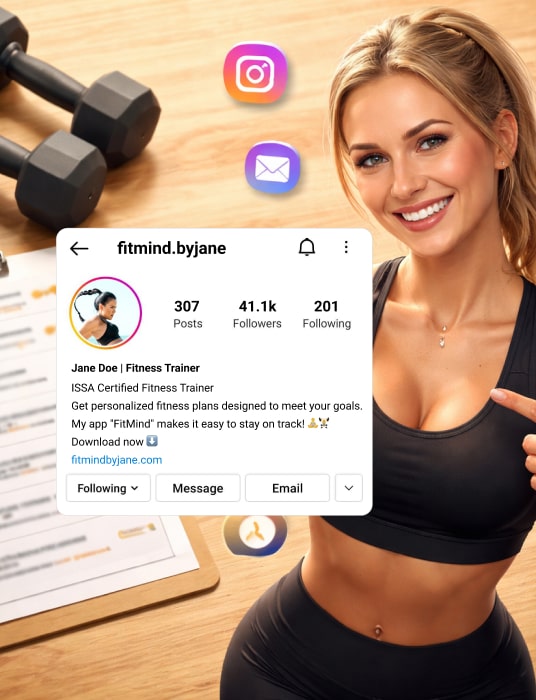Are You Earning Up to Your Potential?
Most personal trainers are undervaluing their time and skills. Our Personal trainer Revenue Calculator helps you find out what you should be making, and how to get there.
No guesswork. Just real numbers.
.jpg)
If you're planning to launch your own personal training business, crafting a solid personal training business plan is your first step toward achieving success. A business plan acts as your fitness coaching roadmap—a strategic document that outlines your vision, goals, target market, revenue model, and everything in between.
Whether you're opening a local gym or building an online coaching brand, your personal training business will need clear direction, strong financial projections, and a defined marketing strategy for trainers. This article will walk you through how to write a PT business plan in 7 actionable steps, using essential industry terms and insights to help you start, grow, and thrive in the competitive fitness industry.
Step 1: Create an Executive Summary and Define Your Business Idea
Your executive summary is the first section of your business plan, but often the last one you'll write. It should summarize your entire personal trainer business plan—including your business idea, target market, services, business goals, and financial highlights—in a clear and compelling manner.
Think of it as the elevator pitch for your personal training business: short, powerful, and persuasive enough to get investors, lenders, or partners interested in reading the rest of your plan.
Key Inclusions:
Mission Statement:
A clear and concise expression of your fitness philosophy, core values, and what you offer potential clients. This statement should reflect your purpose and passion as a trainer, whether it's helping busy professionals stay in shape or empowering people through strength training.
Vision:
Where do you see your training business in 3–5 years? Are you planning to grow into a multi-location gym business, scale your online coaching brand, or become a leader in your niche? Define your long-term fitness business goals clearly and precisely.
Unique Selling Proposition (USP):
What sets your fitness business apart from competitors? You could offer on-demand virtual training, 24/7 access to coaching, specialized programs for athletes or seniors, or focus heavily on mindset and lifestyle coaching. Highlight your unique selling points here—your USP is what makes your business memorable.
Financial Highlights:
Include key numbers that demonstrate viability, such as expected revenue, monthly clients, and profit margins. Even ballpark figures show that you've done your homework and understand what it will take to run a successful business.
This section sets the tone for your entire PT business plan. Investors, lenders, and even potential partners often read it first, so make it impactful. Aim to inspire confidence in your business idea, showcase your professionalism, and convey the clear direction you're heading with your personal training business.
Step 2: Conduct Market Research and a SWOT Analysis

Before launching your training sessions, it's essential to gather detailed information about your audience, competitors, and industry trends. Understanding market demand, buying habits, and the level of competition you'll face lays the groundwork for a smart, strategic, and data-driven business plan.
Effective market research not only helps you fine-tune your services and pricing but also uncovers gaps in the fitness industry that your personal training business can fill. The better you understand your target market, the more effectively you can position yourself as a go-to expert in your niche.
A. Market Analysis
Your market analysis should dig into the specifics of your local or digital fitness landscape.
Ask yourself:
- Who are your potential customers?
Identify your ideal client profile—what problems are they trying to solve, and how can your training business help? - What is your target market's age, lifestyle, and fitness goals?
Are they young professionals with limited time, new moms looking for postnatal fitness, or seniors seeking low-impact workouts? - Are you targeting beginners, athletes, seniors, or corporate clients?
Knowing this helps you tailor your marketing strategy, create more effective messaging, and offer programs aligned with their goals.
You should also assess the fitness facilities and other trainers operating in your area or online. Are they offering services similar to yours? What are their strengths and weaknesses? Use this research to shape a service offering that's more aligned with current market demand and stands out in a competitive space.
B. SWOT Analysis for Fitness Coaches
A SWOT analysis (Strengths, Weaknesses, Opportunities, Threats) provides a comprehensive view of where your own personal training business stands right now—and where it could go.
This kind of strategic analysis is crucial for shaping your PT business plan and making informed decisions about services, pricing, branding, and partnerships.
Strengths
What advantages do you currently have?
- Experienced trainer
- Loyal client base
- Strong online coaching skills
- Clear niche or specialization
- Well-developed social media accounts
Weaknesses
Where could your business be vulnerable?
- Limited startup capital
- No physical location (yet)
- Lack of brand awareness
- Being a new business owner
- Minimal team or support
Opportunities
What trends or market gaps can you capitalize on?
- The growing gym industry and wellness awareness
- Increasing demand for remote coaching and hybrid models
- Untapped demographics (e.g., corporate wellness programs, pre/postnatal clients)
- Content creation and digital fitness coaching roadmap expansion
Threats
What external factors could pose risks?
- Saturated market with intense competition
- Rising operating costs (rent, equipment, advertising)
- Changes in consumer behavior or economic downturns
- New tech-driven apps are reducing the demand for personal trainers
This SWOT analysis framework for fitness coaches helps you identify areas to focus on and those to proceed with caution. You'll be better prepared to pivot your business model, respond to competitor actions, and deliver value to your potential clients.
Include your SWOT analysis directly in your personal trainer business plan to show potential investors and partners that you've thoroughly assessed the landscape and are prepared for both risks and opportunities.
💪 Got an idea for a brand? Let's bring it to life.
Launch your own fitness app with FitBudd in minutes!

💪 Got your brand name? Let’s bring it to life.
Launch your own fitness app with FitBudd in minutes!


88% trainers worldwide gave us 5 stars
Transform your fitness business with the power of your branded app on iOS and Android.
Try for FREEStep 3: Define Your Services and Business Model
What will your fitness business offer? Defining your core services is essential for building a sustainable business model and delivering value to your potential clients. Your services should align with both your trainer business goals and the needs of your target market.
Service Categories:
Consider offering a mix of in-person and digital services to meet client preferences and increase revenue streams:

- 1:1 Personal Training Sessions (in-person or virtual)
Personalized coaching tailored to individual client goals and schedules. - Small Group Training
More affordable for clients and scalable for you. Ideal for social motivation and group dynamics. - Nutrition Planning
A powerful add-on to training that enhances client results and retention. - Mobile Training
Travel to clients' homes, offices, or parks for maximum convenience. - Online Coaching Programs
Pre-recorded or live coaching delivered through a member portal or email. - Fitness App Subscriptions
Offer custom workouts, habit tracking, and progress updates via a mobile platform.
Clarify Your Business Model:
Is your personal training business:
- Subscription-based (monthly/quarterly access)?
- Pay-per-session (flexible, no long-term commitment)?
- Hybrid model (a mix of in-person and online services)?
Choose a structure that matches your business goals, lifestyle, and scalability plans. Hybrid and digital-first models can help you build an online coaching brand and expand your reach beyond local limits.
Set Trainer Business Goals for Service Delivery:
Define operational goals to help measure performance and growth:
- How many clients per month will you serve, and what's your capacity?
- What is your expected retention rate (e.g., 70% of clients stay beyond 3 months)?
- Will you offer tiered packages (e.g., Bronze, Silver, Gold) or memberships?
These details help you refine your fitness coaching pricing strategy, forecast how much revenue you can generate, and optimize your cash flow.
Step 4: Develop a Fitness Coaching Pricing Strategy
Your fitness coaching pricing strategy is more than just numbers—it's a reflection of your brand, your value, and your long-term vision as a personal training business owner. Pricing should be competitive enough to attract potential clients, yet structured to cover your operating costs and drive profitability.
You're not just charging for a workout—you're offering a valuable exercise experience, accountability, and results. Your pricing should reflect that.
Key Considerations:
- How much revenue do you need to cover all the expenses?
Factor in operating expenses like rent, equipment, software, marketing, insurance, and legal costs. This will help you understand your break-even point and build a sustainable financial plan as a fitness coach. - What's your hourly rate or package price?
Decide if you'll charge per session, per month, or offer bundles. For example:- $75 per session
- $250/month for two sessions per week
- $500/month for full access + online coaching
- Will you offer discounts to existing clients or referrals?
Incentivize loyalty and client acquisition by offering referral bonuses, discounted first sessions, or loyalty pricing for long-term clients.
Define Your PT Revenue Plan
Use this section to create your PT revenue plan, including: clearly
- Projected monthly income based on pricing and the number of clients
- Upsell opportunities (e.g., add-on nutrition services, app access, or merchandise)
- Seasonal promotions or tiered memberships
You can also include a break-even analysis to determine how many clients you need to be profitable, and create financial forecasts to map out your growth over 6–12 months.
Your pricing should reflect your unique selling proposition, market demand, and the value clients place on your services. A well-planned pricing strategy supports not only income but also business growth, brand positioning, and overall success in the competitive fitness industry.
Step 5: Build a Client Acquisition Plan and Marketing Strategy
Clients are the lifeblood of any service business. Your client acquisition plan should outline how you'll attract, convert, and retain both new clients and existing clients. A straightforward, consistent process for lead generation and follow-up is essential to ensure a steady stream of prospects entering your personal training business.
A. Marketing Strategy for Trainers:
- Professional website:
Acts as a 24/7 sales machine for your services. It should include your bio, service offerings, testimonials, pricing, and a contact or booking form. Your website should reflect your brand and professionalism. - Social media accounts:
Leverage Instagram, Facebook, and TikTok to share workouts, testimonials, and behind-the-scenes content. Regular posting builds trust and keeps you visible in a crowded fitness industry. - Social media ads:
Targeted ads help you reach your target market based on demographics and interests. Use ads to promote limited-time offers, free consultations, or unique programs. - Email marketing:
Automate newsletters, offers, and client updates. It's also an excellent channel for nurturing leads, promoting new packages, and re-engaging inactive clients.
Your marketing plan should reflect your unique selling points and include channels with the highest return on investment (ROI) for your target audience. Incorporating consistent branding, strong calls-to-action, and measurable goals into your marketing strategy helps you build visibility, grow trust, and ultimately drive conversions. Over time, this approach supports scalable business growth and creates a strong foundation for your personal training business plan.
Step 6: Create Your Gym Operations Plan and Management Structure
Your gym business plan or online coaching business still needs a clear operational structure to function efficiently. A well-organized gym operations plan ensures a seamless experience for your clients and supports your long-term business goals.
Operations Overview:
- Daily Schedule:
Outline what a typical training day looks like, including client sessions, admin work, content creation, and breaks. Establishing a routine boosts productivity and consistency in service delivery. - Booking System:
How clients schedule sessions—will you use apps like Calendly, Acuity, or a built-in feature on your professional website? An easy-to-use system improves the client experience and reduces no-shows. - Payment Processing:
Will you accept payments via Stripe, PayPal, or bank transfer? Set up secure, automated payment methods to streamline cash flow and reduce missed payments. - Facilities:
Will you work out of a studio, home gym, or client's location? Describe how you'll manage space, safety, cleanliness, and accessibility in each setting. - Gym Equipment Needs and Maintenance:
List the essential gym equipment you'll need for different types of sessions. Include a plan for regular maintenance, replacements, and a budget for upgrades as your fitness business grows.
Management Team:
If you're a self-employed personal trainer, you may be handling all roles at the start: trainer, marketer, scheduler, and accountant. Identify each role you currently manage and any tools or systems used to support them.
However, if your business growth strategy includes hiring, partnerships, or franchising, outline your management team structure and responsibilities. Specify who will handle operations, marketing, client management, and finance in the future. This helps attract potential investors and demonstrates that you're planning for long-term business goals in the fitness industry.
Having a solid management structure, even as a solo operator, builds trust, enhances scalability, and contributes to the overall success of your personal training business plan.
Step 7: Build Your Financial Plan and Forecasts
This is the most crucial section for securing financial support, attracting potential investors, and ensuring business success.
A. Financial Plan for Fitness Coaches:
- Startup Costs: Include legal costs, gym equipment, website development, branding, and licenses.
- Operating Costs: Recurring monthly expenses like rent, software, marketing, and utilities.
- Revenue Projections: How much do you expect to earn monthly and annually?
- Profit Margins: Estimate based on projected income minus costs.
B. Financial Forecasts:
- Break-even analysis: At what point will your own fitness business cover its costs and become profitable?
- Cash flow projections: Monthly inflow and outflow of money.
- Financial projections: 1-year, 3-year, and 5-year outlooks.
Having a clear financial plan, a fitness coach model ensures that your business owner's mindset stays focused on sustainability and business growth.
Bonus Tips for a Successful PT Business Plan
Here are some extra tips to help you achieve success with your PT business plan:
- Use a business plan template: This helps organize your thoughts and ensures you include all essential sections.
- Answer a few questions: Ask yourself things like, "What are my long-term fitness business goals?" and "What will success look like in 1 year?"
- Attract investors with clarity: Highlight your unique selling proposition, market analysis, and financial forecasts to demonstrate your business's viability.
- Focus on value: Whether online or in a studio, offer valuable exercise programs that deliver results.
- Track and adjust: Use analytics to monitor your marketing and service performance, then optimize as needed.
Final Thoughts
Crafting a personal training business plan is more than a paperwork task—it's the blueprint for your own business in the fitness industry. With a well-researched and thoughtful approach, you can stand out from the competition, build a loyal client base, and create a successful business doing what you love.
From setting business goals to building a standout marketing strategy, and from managing operating expenses to forecasting future growth, your startup guide personal training should leave no stone unturned.
So, whether you're a new business owner looking to get your first clients or an experienced trainer seeking to scale, a well-crafted plan will help you achieve success in one of the most successful businesses of the decade: personal training.
Frequently Asked Questions
To create a business plan for personal training, follow a structured approach that includes: An executive summary explaining your business idea, mission statement, and goals. A market analysis identifying your target market, competition, and market demand. A detailed description of your services and business model (e.g., 1:1 sessions, online coaching, group training). A SWOT analysis to evaluate your strengths, weaknesses, opportunities, and threats in the fitness industry. A marketing strategy for trainers using social media, ads, and email campaigns to attract and retain clients. An operations plan outlining daily workflows, booking systems, and facilities. A financial plan for fitness coaches, including revenue projections, expenses, and a break-even analysis. Use a business plan template to organize your thoughts and make your personal trainer business plan investor-ready.
Yes, being a personal trainer can be a profitable business, especially when you choose the right business model, define your pricing strategy, and create a solid client acquisition plan. You can increase revenue by offering a range of services, such as online coaching, personalized nutrition planning, or fitness challenges. Many self-employed personal trainers build successful brands by leveraging their social media accounts, creating online fitness programs, and expanding their business through group training or memberships. The key to profitability lies in managing operating costs effectively, increasing client retention, and scaling your offerings over time. A strong financial plan, combined with the guidance of a fitness coach, can help you track cash flow, monitor expenses, and grow strategically.
To start your training business, follow these essential steps: Define your business goals and target market. Get certified and ensure all legal requirements (insurance, liability waivers) are covered. Create a detailed personal training business plan with a clear fitness coaching roadmap. Choose your business model—in-person, mobile, online, or hybrid. Set up your professional website, booking system, and payment processing tools. Design a compelling marketing strategy to reach potential clients through social media, email, and referrals. Launch your services, collect feedback, and adjust your offerings based on market needs. A startup guide personal training plan helps streamline each step, ensuring a strong foundation for a successful business.
To create a personal training plan for a client, you need to: Begin by assessing the client's current fitness level, goals, medical history, and lifestyle. Define short-term and long-term fitness business goals tailored to their needs (e.g., weight loss, muscle gain, endurance). Build a structured weekly workout routine, including strength, cardio, flexibility, and recovery sessions. Incorporate progress tracking, adjustments, and regular check-ins to measure results. Optionally, add nutritional guidance, habit coaching, or support through a fitness app subscription. Whether you're designing in-person or online personal training programs, your plan should deliver a valuable exercise experience that's safe, personalized, and aligned with the client's goals.

Ultimate Marketing Guide for Fitness Trainers
Boost your business growth with these tried and tested marketing strategies. Free for you to download.
Download Now
Templates
These functional templates have the power to make any fitness trainer's life easier.
Subscribe To
Our Blog
































